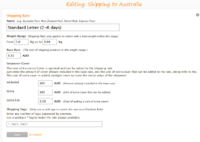Adding Shipping Insurance Cover to your shipping rates
From Spiffy Stores Knowledge Base
Revision as of 13:05, 31 July 2025 by Admin (talk | contribs) (→How does insurance cover get calculated?)
In an ideal world, parcels would never get lost.
Unfortunately this is something that all online merchants encounter from time to time. That's where Shipping Insurance comes in. Depending upon the shipping company you choose to use, you may find that your shipments are already covered for loss up to a certain value limit, and that additional cover is available for a small fee.
Contents
What is Shipping Insurance?
If a carrier loses your parcel, then they will reimburse you for the value of the lost item, up to a maximum limit defined by the level of cover purchased.
In order to get insurance for a parcel, you will pay a small fee for each parcel, depending on the value of the item that you are trying to cover.
Why do I need Shipping Insurance
In general, the shipping rates that you define for your store will define the cost of shipping your parcels to the customer, and these are mostly based upon the weight of the parcels. That means that items that are physically similar will cost the same to ship, regardless of whether the item is worth $5 or $500. If your $500 item goes missing, then that's a way bigger problem than if the $5 item has been lost.
Shipping Insurance means that you are relieved of the risk of dealing with these potentially big losses.
What are some examples of insurance cover?
The prices quoted here are valid as of August, 2025. Please check with the carriers directly for the current terms.
For Australian customers, the national carrier, Australia Post provides a standard cover of $100 for all items. The cost of this is already included in the price of sending the item. For additional cover, Australia Post charges $2.50 for each additional $100 of cover that is added to cover the full value of the item.
Sendle also offer a standard cover of $100. They charge $1.95 for each additional $100 of cover.
Many couriers offer a similar scheme of additional cover above and beyond an included amount, typically $100, and the actual terms can be obtained by contacting the companies directly.
How do I incorporate the cost of insurance into my shipping rates?
Until now, it's been possible to utilize Checkout Rules to select different Shipping Tags based upon the cart value. In order to use this method, it's necessary to create a separate shipping rate for each level of insurance cover that you want to support, which is slightly cumbersome.
The process of adding support for insurance cover for a shipping rate has now been drastically simplified, and the insurance cover rules can now be directly defined in the shipping rate.
This is the process for adding Insurance Cover to a Shipping Rate. Please note that currently, only Weight-Based shipping rates support insurance cover.
- Navigate to your "Preferences -> Shipping & Handling" page.
- Select the shipping rate you want to modify. Just click on the rate to view it.
- When you have selected the Shipping Rate, click on "Edit" to edit the rate.
- On the edit page, you should see three fields under the heading "Insurance Cover". If you can't see this section, you are not editing a weight-based rate.
- Enter the amount of included cover in the Included field. For example, 100.
- Enter the amount of extra cover per unit that can be added in the Extra field. For example, 100.
- Finally, enter the cost of each unit of extra cover in the Extra Fee field. For example, 2.50.
- Click "Save" to save your updated. Note that if you enter a value in one of these fields, then you must provide a value for all three fields.
How does insurance cover get calculated?
When you add insurance cover to a shipping rate, the system looks at the value of the items in each parcel and automatically adds extra cover to the cost of shipping if needed.
For standard weight-based rates, the items in the cart are treated as belonging to a single parcel, except for any items specifically excluded such as those tagged as requiring separate shipping for bulky items, or items that use a specific shipping code.
When a shipping agent calculator is used, the items in the cart may be assigned to multiple parcels, depending on their weights and dimensions, in order to fit within the limits of the various shipping rates provided by the carrier.
Once the parcels have been determined for the cart, the value of each parcel is compared to the insurance cover limits and an additional fee is added for each parcel if the value exceeds the included cover value.
Please be aware that sometimes the parcel optimization may assign items to different parcels in order to find the cheapest shipping rates available. This can often result in the values of each parcel falling below the included cover limit and therefore skipping any extra cover charge. It's important to observe the recommendations of the parcel breakdown in the order overview in order to correctly determine which parcels need additional cover. The parcels requiring extra cover are highlighted on the order when you view if from the "Orders" page.
The customer will also be informed if there is an additional charge on a shipping rate to add extra cover for shipping.

